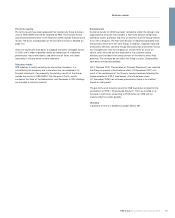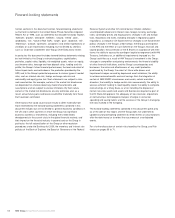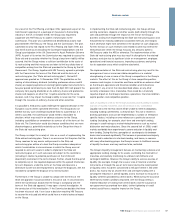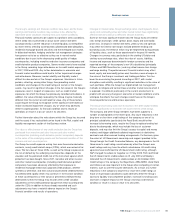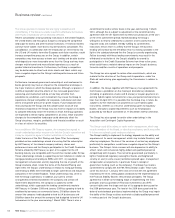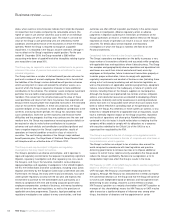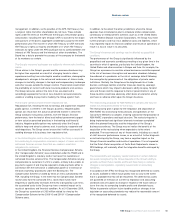RBS 2009 Annual Report Download - page 59
Download and view the complete annual report
Please find page 59 of the 2009 RBS annual report below. You can navigate through the pages in the report by either clicking on the pages listed below, or by using the keyword search tool below to find specific information within the annual report.
57RBS Group Annual Report and Accounts 2009
Business review
As a result of the First Placing and Open Offer (approved as part of the
Commission’s approval of a package of measures to the banking
industry in the UK in October 2008), the Group was required to
cooperate with HM Treasury to submit a forward plan to the
Commission. This plan was submitted and detailed discussions took
place between HM Treasury, the Group and the Commission. The plan
submitted not only had regard to the First Placing and Open Offer, but
also the B share issue (including the Contingent Subscription) and the
Group’s participation in the UK Government’s Asset Protection Scheme
(APS). As part of its review, the Commission was required to assess the
State aid and to consider whether the Group’s long-term viability will be
assured, that the Group makes a sufficient contribution to the costs of
its restructuring and that measures are taken to limit any distortions of
competition arising from the State aid provided to the Group by the UK
Government. The Group, together with HM Treasury, agreed in principle
with the Commission the terms of the State aid and the terms of a
restructuring plan (the “State aid restructuring plan”). Formal EC
approval was granted on 14 December 2009. The prohibition on the
making of discretionary dividend (including preference shares and B
shares) or coupon payments on existing hybrid capital instruments for a
two-year period commencing no later than 30 April 2010 will prevent the
company from paying dividends on its ordinary shares and preference
shares and coupons on other Tier 1 capital securities for the same
duration, and it may impair the Group’s ability to raise new Tier 1 Capital
through the issuance of ordinary shares and other securities.
It is possible a third party could challenge the approval decision in the
European Courts (within specified time limits). The Group does not
believe that any such challenge would be likely to succeed but, if it
were to succeed, the Commission would need to reconsider its
decision, which may result in an adverse outcome for the Group,
including a prohibition or amendment to some or all of the terms of the
State aid. The Commission could also impose conditions that are more
disadvantageous, potentially materially so, to the Group than those in
the State aid restructuring plan.
The Group is subject to a variety of risks as a result of implementing the
State aid restructuring plan. There is no assurance that the price that the
Group receives for any assets sold pursuant to the State aid
restructuring plan will be at a level the Group considers adequate or
which it could obtain in circumstances in which the Group was not
required to sell such assets in order to implement the State aid
restructuring plan or if such sale were not subject to the restrictions
(including in relation to potential purchasers of the UK branch
divestment) contained in the terms thereof. Further, should the Group fail
to complete any of the required disposals within the agreed timeframes
for such disposals, under the terms of the State aid clearance a
divestiture trustee can be empowered to conduct the disposals, with the
mandate to complete the disposal at no minimum price.
Furthermore, if the Group is unable to comply with the terms of the
State aid approval it could constitute a misuse of aid. In circumstances
where the Commission doubts that the Group is complying with the
terms of the State aid approval, it may open a formal investigation. At
the conclusion of this investigation, if the Commission decides that there
has been misuse of aid, it can issue a decision requiring HM Treasury
to recover the misused aid which could have a material adverse impact
on the Group.
In implementing the State aid restructuring plan, the Group will lose
existing customers, deposits and other assets (both directly through the
sale and potentially through the impact on the rest of the Group’s
business arising from implementing the State aid restructuring plan) and
the potential for realising additional associated revenues and margins
that it otherwise might have achieved in the absence of such disposals.
Further, the loss of such revenues and related income may extend the
time period over which the Group may pay any amounts owed to
HM Treasury under the APS or otherwise. The implementation of the
State aid restructuring plan may also result in disruption to the retained
business and give rise to significant strain on management, employee,
operational and financial resources, impacting customers and giving
rise to separation costs which could be substantial.
The implementation of the State aid restructuring plan may result in the
emergence of one or more new viable competitors or a material
strengthening of one or more of the Group’s competitors in the Group’s
markets. The effect of this on the Group’s future competitive position,
revenues and margins is uncertain and there could be an adverse effect
on the Group’s operations and financial condition and its business
generally. If any or all of the risks described above, or any other
currently unforeseen risks, materialise, there could be a materially
negative impact on the Group’s business, operations, financial condition,
capital position and competitive position.
Lack of liquidity is a risk to the Group’s business and its ability to access
sources of liquidity has been, and will continue to be, constrained.
Liquidity risk is the risk that a bank will be unable to meet its obligations,
including funding commitments, as they fall due. This risk is inherent in
banking operations and can be heightened by a number of enterprise
specific factors, including an over-reliance on a particular source of
funding (including, for example, short-term and overnight funding),
changes in credit ratings or market-wide phenomena such as market
dislocation and major disasters. Since the second half of 2008, credit
markets worldwide have experienced a severe reduction in liquidity and
term-funding. During this time, perception of counterparty risk between
banks also increased significantly. This increase in perceived counterparty
risk also led to reductions in inter-bank lending, and hence, in common
with many other banking groups, the Group’s access to traditional sources
of liquidity has been, and may continue to be, restricted.
The Group’s liquidity management focuses on maintaining a diverse and
appropriate funding strategy for its assets, controlling the mismatch of
maturities and carefully monitoring its undrawn commitments and
contingent liabilities. However, the Group’s ability to access sources of
liquidity (for example, through the issue or sale of financial and other
instruments or through the use of term loans) during the recent period
of liquidity stress has been constrained to the point where it, like other
banks, has had to rely on shorter term and overnight funding with a
consequent reduction in overall liquidity, and to increase its recourse to
liquidity schemes provided by central banks. While during the course of
2009 money market conditions improved, with the Group seeing a
material reduction of funding from central banks and the issuance of
non-government guaranteed term debt, further tightening of credit
markets could have a negative impact on the Group.






